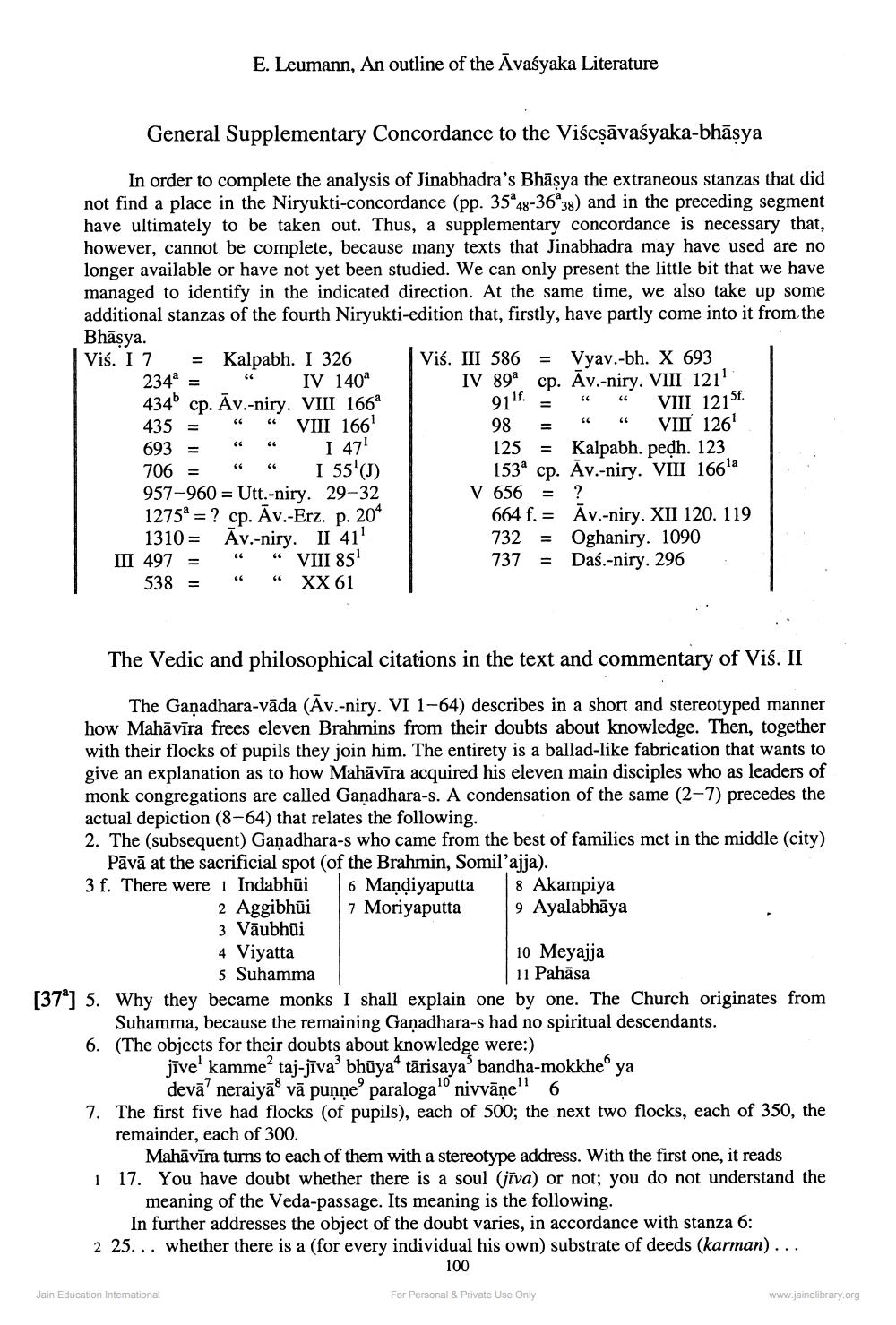________________
General Supplementary Concordance to the Viseṣāvaśyaka-bhāṣya
In order to complete the analysis of Jinabhadra's Bhāṣya the extraneous stanzas that did not find a place in the Niryukti-concordance (pp. 3548-36°38) and in the preceding segment have ultimately to be taken out. Thus, a supplementary concordance is necessary that, however, cannot be complete, because many texts that Jinabhadra may have used are no longer available or have not yet been studied. We can only present the little bit that we have managed to identify in the indicated direction. At the same time, we also take up some additional stanzas of the fourth Niryukti-edition that, firstly, have partly come into it from the Bhāṣya.
Viś. I 7
=
234a = 434b
Kalpabh. I 326 IV 140a
66
cp. Av.-niry. VIII 166a
VIII 1661
435 =
693 =
706 =
957-960
1275 1310
III 497 =
538 =
66
E. Leumann, An outline of the Avasyaka Literature
66
Ce
Jain Education International
Co
Utt.-niry. 29-32
? cp. Av.-Erz. p. 204 Av.-niry. II 41'
VIII 851
XX 61
66
66
I 471 I 55'(J)
(C
Vyav.-bh. X 693 IV 89a cp. Av.-niry. VIII 121')
91lf.
66
=
VIII 1215f.
98 =
VIII 1261
125 =
Kalpabh. pedh. 123
153 cp. Av.-niry. VIII 1661a
V 656 =
?
664 f. 732 737
Viś. III 586
4 Viyatta
5 Suhamma
2 Aggibhūi 7 Moriyaputta
3 Vāubhūi
=
=
66
The Vedic and philosophical citations in the text and commentary of Viś. II
The Gaṇadhara-vada (Av.-niry. VI 1-64) describes in a short and stereotyped manner how Mahāvīra frees eleven Brahmins from their doubts about knowledge. Then, together with their flocks of pupils they join him. The entirety is a ballad-like fabrication that wants to give an explanation as to how Mahāvīra acquired his eleven main disciples who as leaders of monk congregations are called Ganadhara-s. A condensation of the same (2-7) precedes the actual depiction (8-64) that relates the following.
2. The (subsequent) Gaṇadhara-s who came from the best of families met in the middle (city) Pāvā at the sacrificial spot (of the Brahmin, Somil'ajja).
3 f. There were 1 Indabhūi 6 Mandiyaputta
6. (The objects for their doubts about knowledge were:)
66
66
Av.-niry. XII 120. 119
Oghaniry. 1090
Daś.-niry. 296
8 Akampiya
9 Ayalabhāya
10 Meyajja
11 Pahāsa
[37] 5. Why they became monks I shall explain one by one. The Church originates from Suhamma, because the remaining Ganadhara-s had no spiritual descendants.
jīve' kamme2 taj-jīva3 bhūya tārisaya bandha-mokkhe deva' neraiya va punne' paraloga1 nivvāṇe11 6
7. The first five had flocks (of pupils), each of 500; the next two flocks, each of 350, the remainder, each of 300.
ya
Mahāvīra turns to each of them with a stereotype address. With the first one, it reads
1
17. You have doubt whether there is a soul (jiva) or not; you do not understand the meaning of the Veda-passage. Its meaning is the following.
In further addresses the object of the doubt varies, in accordance with stanza 6:
2 25... whether there is a (for every individual his own) substrate of deeds (karman)...
100
For Personal & Private Use Only
www.jainelibrary.org




